Strategic Marketing Plan: Fast Food Industry and Lotteria Analysis
VerifiedAdded on 2023/06/03
|8
|1563
|313
Report
AI Summary
This report provides a strategic marketing plan for Lotteria, a fast-food company. It begins with an assessment of the competitive industry, identifying key competitors like McDonald's, Jollibee, and Burger King. A positional map is used to visualize Lotteria's market position relative to its competitors, considering price and quality. The report then analyzes the industry's five competitive forces, including the bargaining power of buyers, suppliers, the threat of substitutes, new entrants, and competitive rivalry. Critical success factors for Lotteria, such as product quality, menu, and brand image, are discussed. Finally, the report outlines Lotteria's competitive advantages, including product and service differentiation, and disadvantages, such as high prices compared to competitors. The analysis highlights the intense competition within the fast-food industry and the importance of strategic marketing to maintain and improve Lotteria's market position.
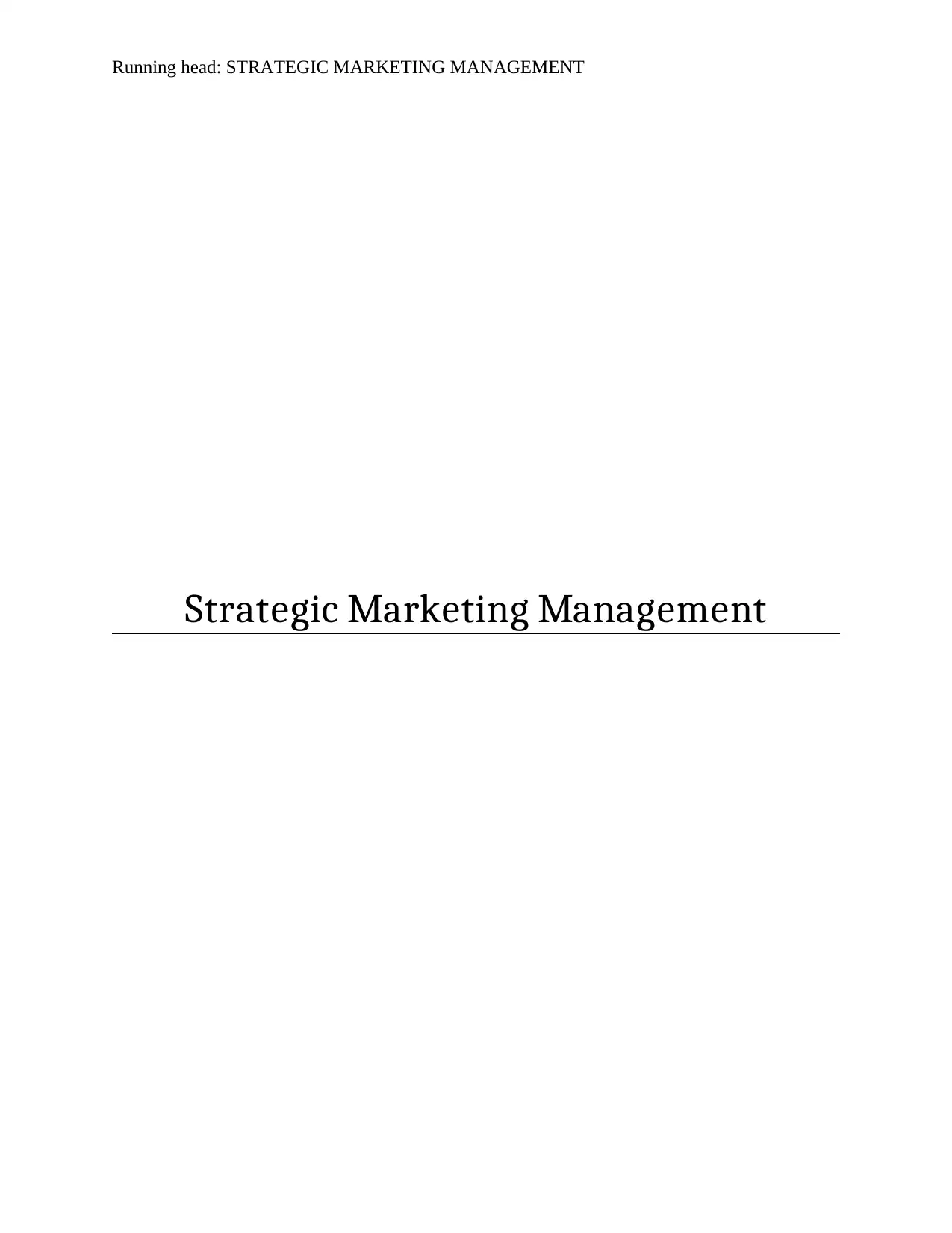
Running head: STRATEGIC MARKETING MANAGEMENT
Strategic Marketing Management
Strategic Marketing Management
Paraphrase This Document
Need a fresh take? Get an instant paraphrase of this document with our AI Paraphraser
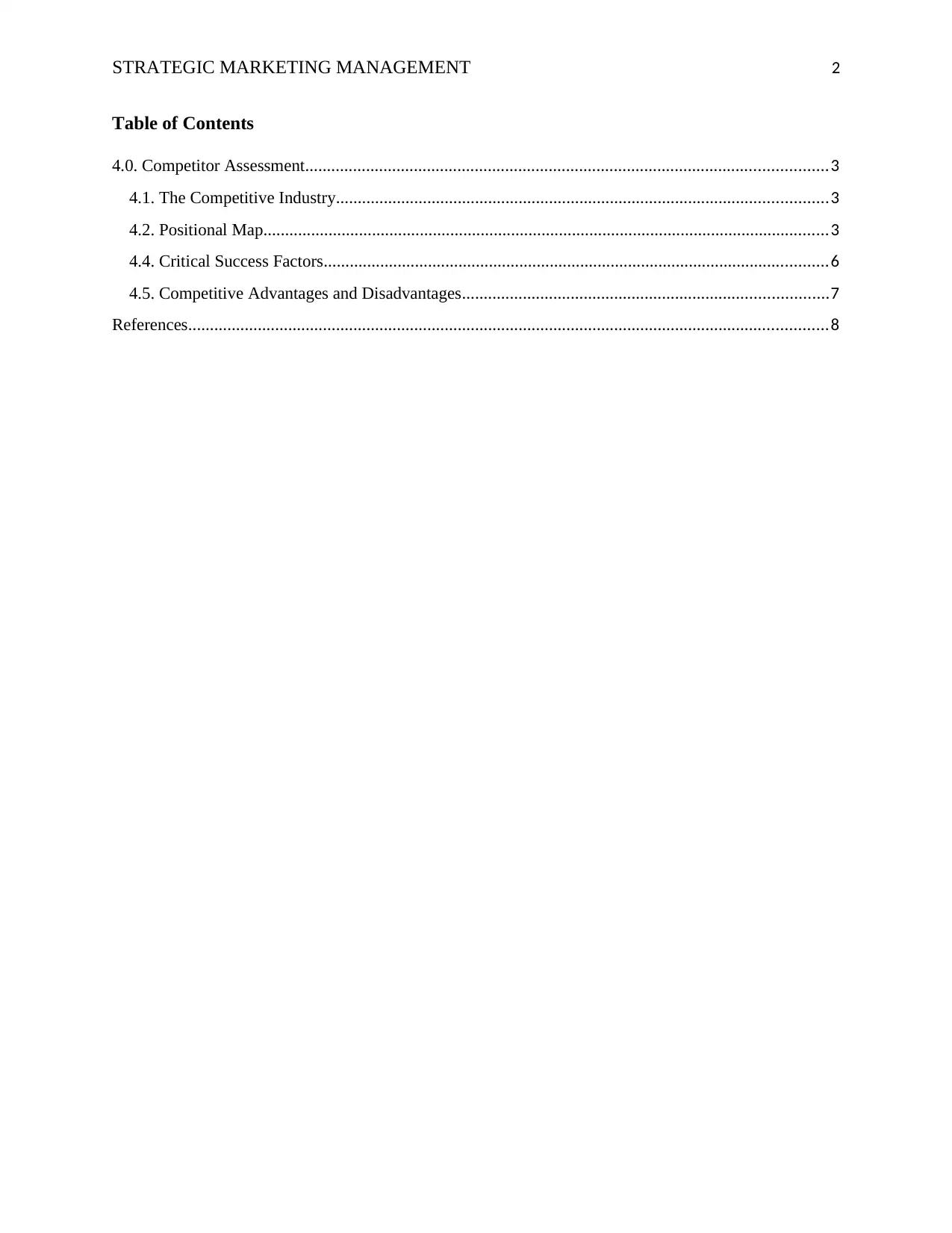
STRATEGIC MARKETING MANAGEMENT 2
Table of Contents
4.0. Competitor Assessment........................................................................................................................3
4.1. The Competitive Industry.................................................................................................................3
4.2. Positional Map..................................................................................................................................3
4.4. Critical Success Factors....................................................................................................................6
4.5. Competitive Advantages and Disadvantages....................................................................................7
References...................................................................................................................................................8
Table of Contents
4.0. Competitor Assessment........................................................................................................................3
4.1. The Competitive Industry.................................................................................................................3
4.2. Positional Map..................................................................................................................................3
4.4. Critical Success Factors....................................................................................................................6
4.5. Competitive Advantages and Disadvantages....................................................................................7
References...................................................................................................................................................8
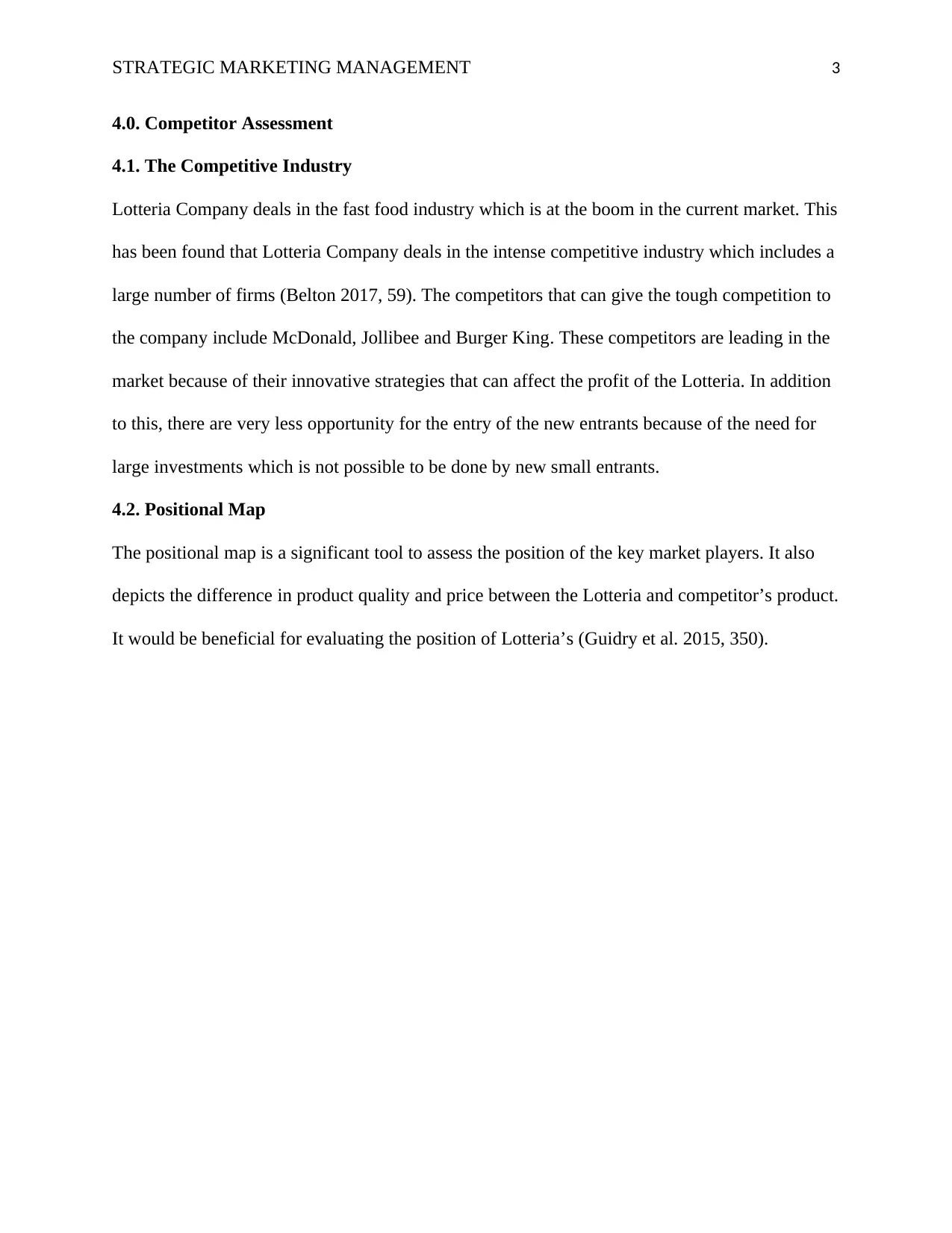
STRATEGIC MARKETING MANAGEMENT 3
4.0. Competitor Assessment
4.1. The Competitive Industry
Lotteria Company deals in the fast food industry which is at the boom in the current market. This
has been found that Lotteria Company deals in the intense competitive industry which includes a
large number of firms (Belton 2017, 59). The competitors that can give the tough competition to
the company include McDonald, Jollibee and Burger King. These competitors are leading in the
market because of their innovative strategies that can affect the profit of the Lotteria. In addition
to this, there are very less opportunity for the entry of the new entrants because of the need for
large investments which is not possible to be done by new small entrants.
4.2. Positional Map
The positional map is a significant tool to assess the position of the key market players. It also
depicts the difference in product quality and price between the Lotteria and competitor’s product.
It would be beneficial for evaluating the position of Lotteria’s (Guidry et al. 2015, 350).
4.0. Competitor Assessment
4.1. The Competitive Industry
Lotteria Company deals in the fast food industry which is at the boom in the current market. This
has been found that Lotteria Company deals in the intense competitive industry which includes a
large number of firms (Belton 2017, 59). The competitors that can give the tough competition to
the company include McDonald, Jollibee and Burger King. These competitors are leading in the
market because of their innovative strategies that can affect the profit of the Lotteria. In addition
to this, there are very less opportunity for the entry of the new entrants because of the need for
large investments which is not possible to be done by new small entrants.
4.2. Positional Map
The positional map is a significant tool to assess the position of the key market players. It also
depicts the difference in product quality and price between the Lotteria and competitor’s product.
It would be beneficial for evaluating the position of Lotteria’s (Guidry et al. 2015, 350).
⊘ This is a preview!⊘
Do you want full access?
Subscribe today to unlock all pages.

Trusted by 1+ million students worldwide
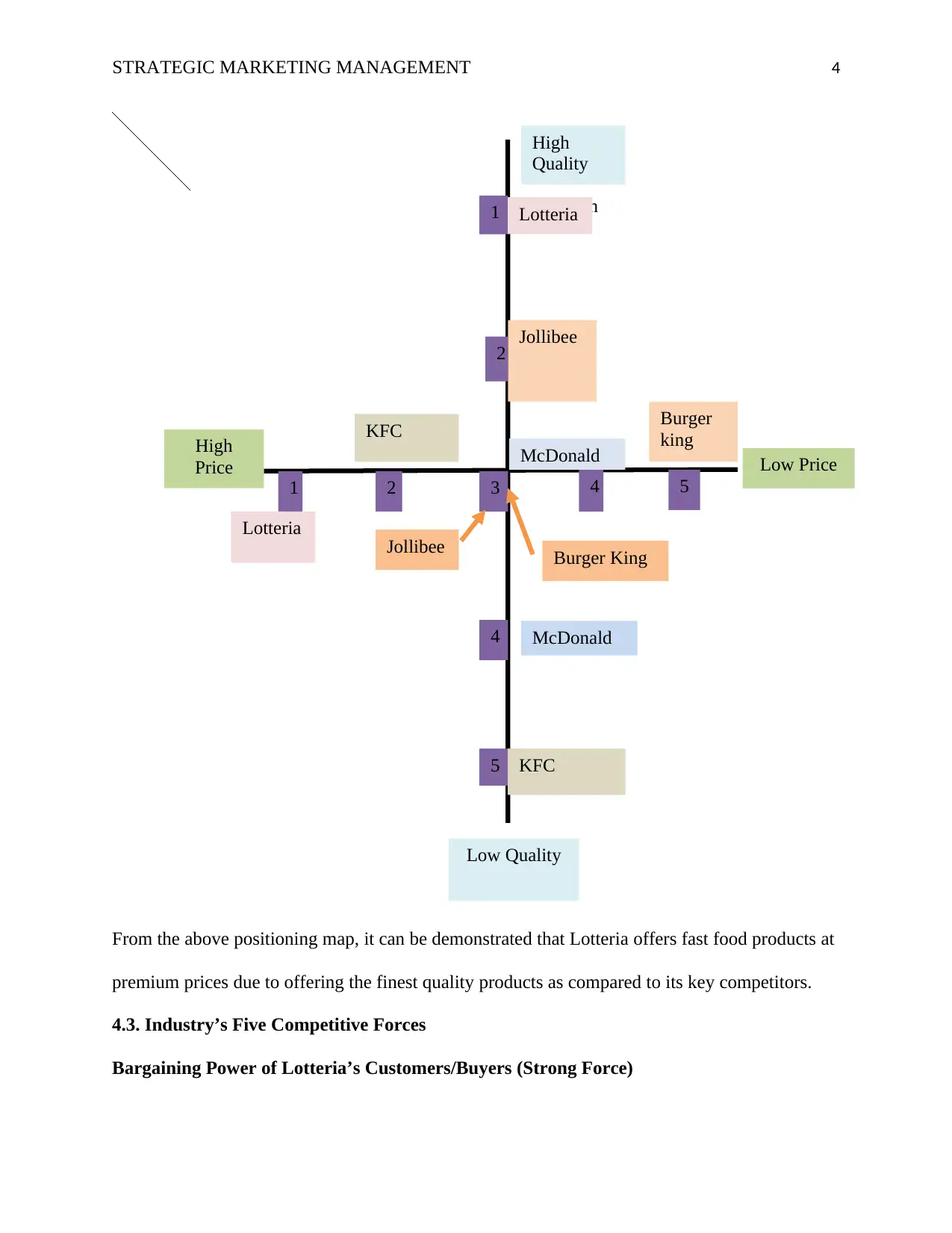
Jollibee
1 2 3 4 5
1
2
4
5
Low Price
Low Quality
High
Quality
Ver high
High
Price
Burger
kingKFC
Lotteria
McDonald
McDonald
Lotteria
Jollibee
KFC
Burger King
STRATEGIC MARKETING MANAGEMENT 4
From the above positioning map, it can be demonstrated that Lotteria offers fast food products at
premium prices due to offering the finest quality products as compared to its key competitors.
4.3. Industry’s Five Competitive Forces
Bargaining Power of Lotteria’s Customers/Buyers (Strong Force)
1 2 3 4 5
1
2
4
5
Low Price
Low Quality
High
Quality
Ver high
High
Price
Burger
kingKFC
Lotteria
McDonald
McDonald
Lotteria
Jollibee
KFC
Burger King
STRATEGIC MARKETING MANAGEMENT 4
From the above positioning map, it can be demonstrated that Lotteria offers fast food products at
premium prices due to offering the finest quality products as compared to its key competitors.
4.3. Industry’s Five Competitive Forces
Bargaining Power of Lotteria’s Customers/Buyers (Strong Force)
Paraphrase This Document
Need a fresh take? Get an instant paraphrase of this document with our AI Paraphraser
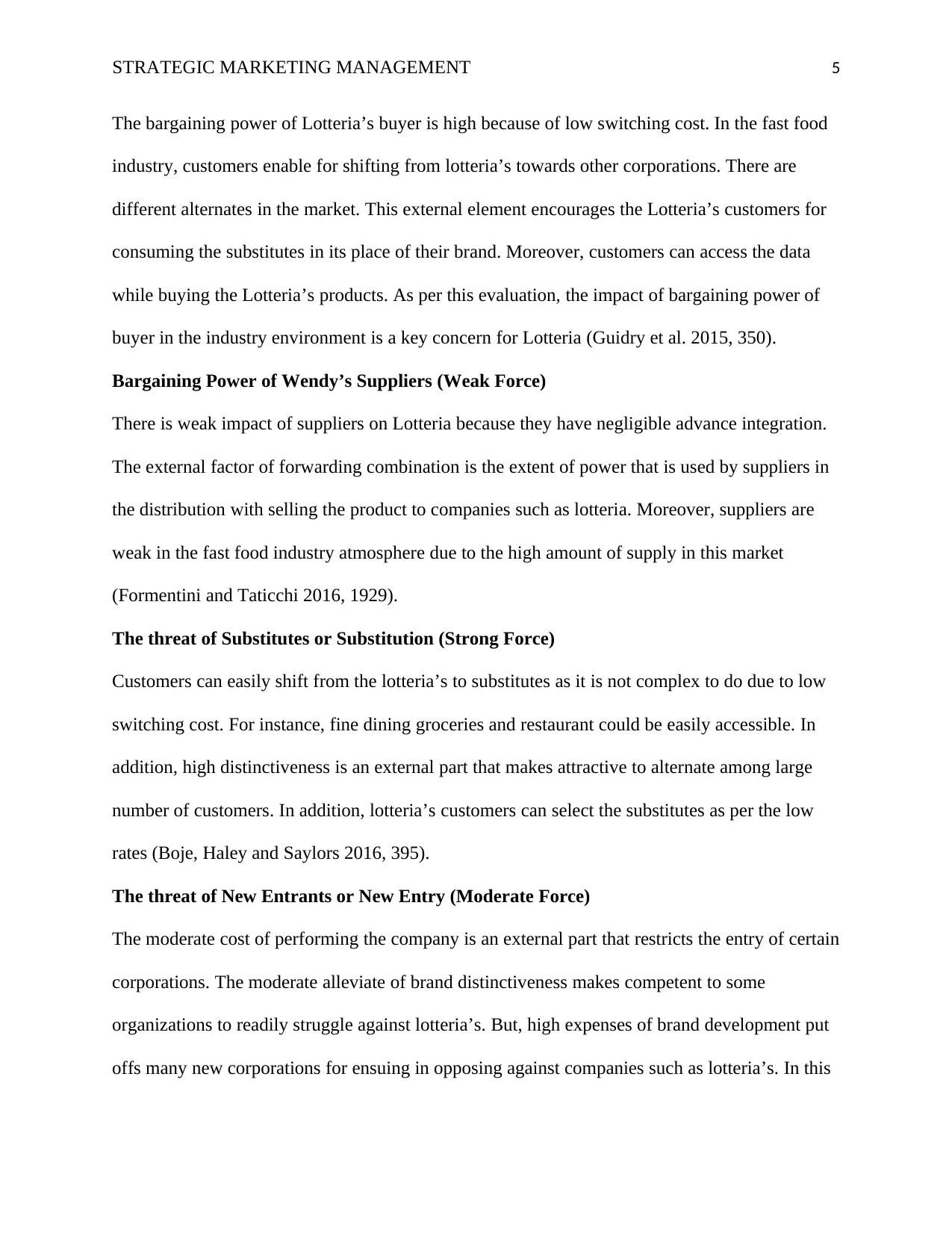
STRATEGIC MARKETING MANAGEMENT 5
The bargaining power of Lotteria’s buyer is high because of low switching cost. In the fast food
industry, customers enable for shifting from lotteria’s towards other corporations. There are
different alternates in the market. This external element encourages the Lotteria’s customers for
consuming the substitutes in its place of their brand. Moreover, customers can access the data
while buying the Lotteria’s products. As per this evaluation, the impact of bargaining power of
buyer in the industry environment is a key concern for Lotteria (Guidry et al. 2015, 350).
Bargaining Power of Wendy’s Suppliers (Weak Force)
There is weak impact of suppliers on Lotteria because they have negligible advance integration.
The external factor of forwarding combination is the extent of power that is used by suppliers in
the distribution with selling the product to companies such as lotteria. Moreover, suppliers are
weak in the fast food industry atmosphere due to the high amount of supply in this market
(Formentini and Taticchi 2016, 1929).
The threat of Substitutes or Substitution (Strong Force)
Customers can easily shift from the lotteria’s to substitutes as it is not complex to do due to low
switching cost. For instance, fine dining groceries and restaurant could be easily accessible. In
addition, high distinctiveness is an external part that makes attractive to alternate among large
number of customers. In addition, lotteria’s customers can select the substitutes as per the low
rates (Boje, Haley and Saylors 2016, 395).
The threat of New Entrants or New Entry (Moderate Force)
The moderate cost of performing the company is an external part that restricts the entry of certain
corporations. The moderate alleviate of brand distinctiveness makes competent to some
organizations to readily struggle against lotteria’s. But, high expenses of brand development put
offs many new corporations for ensuing in opposing against companies such as lotteria’s. In this
The bargaining power of Lotteria’s buyer is high because of low switching cost. In the fast food
industry, customers enable for shifting from lotteria’s towards other corporations. There are
different alternates in the market. This external element encourages the Lotteria’s customers for
consuming the substitutes in its place of their brand. Moreover, customers can access the data
while buying the Lotteria’s products. As per this evaluation, the impact of bargaining power of
buyer in the industry environment is a key concern for Lotteria (Guidry et al. 2015, 350).
Bargaining Power of Wendy’s Suppliers (Weak Force)
There is weak impact of suppliers on Lotteria because they have negligible advance integration.
The external factor of forwarding combination is the extent of power that is used by suppliers in
the distribution with selling the product to companies such as lotteria. Moreover, suppliers are
weak in the fast food industry atmosphere due to the high amount of supply in this market
(Formentini and Taticchi 2016, 1929).
The threat of Substitutes or Substitution (Strong Force)
Customers can easily shift from the lotteria’s to substitutes as it is not complex to do due to low
switching cost. For instance, fine dining groceries and restaurant could be easily accessible. In
addition, high distinctiveness is an external part that makes attractive to alternate among large
number of customers. In addition, lotteria’s customers can select the substitutes as per the low
rates (Boje, Haley and Saylors 2016, 395).
The threat of New Entrants or New Entry (Moderate Force)
The moderate cost of performing the company is an external part that restricts the entry of certain
corporations. The moderate alleviate of brand distinctiveness makes competent to some
organizations to readily struggle against lotteria’s. But, high expenses of brand development put
offs many new corporations for ensuing in opposing against companies such as lotteria’s. In this
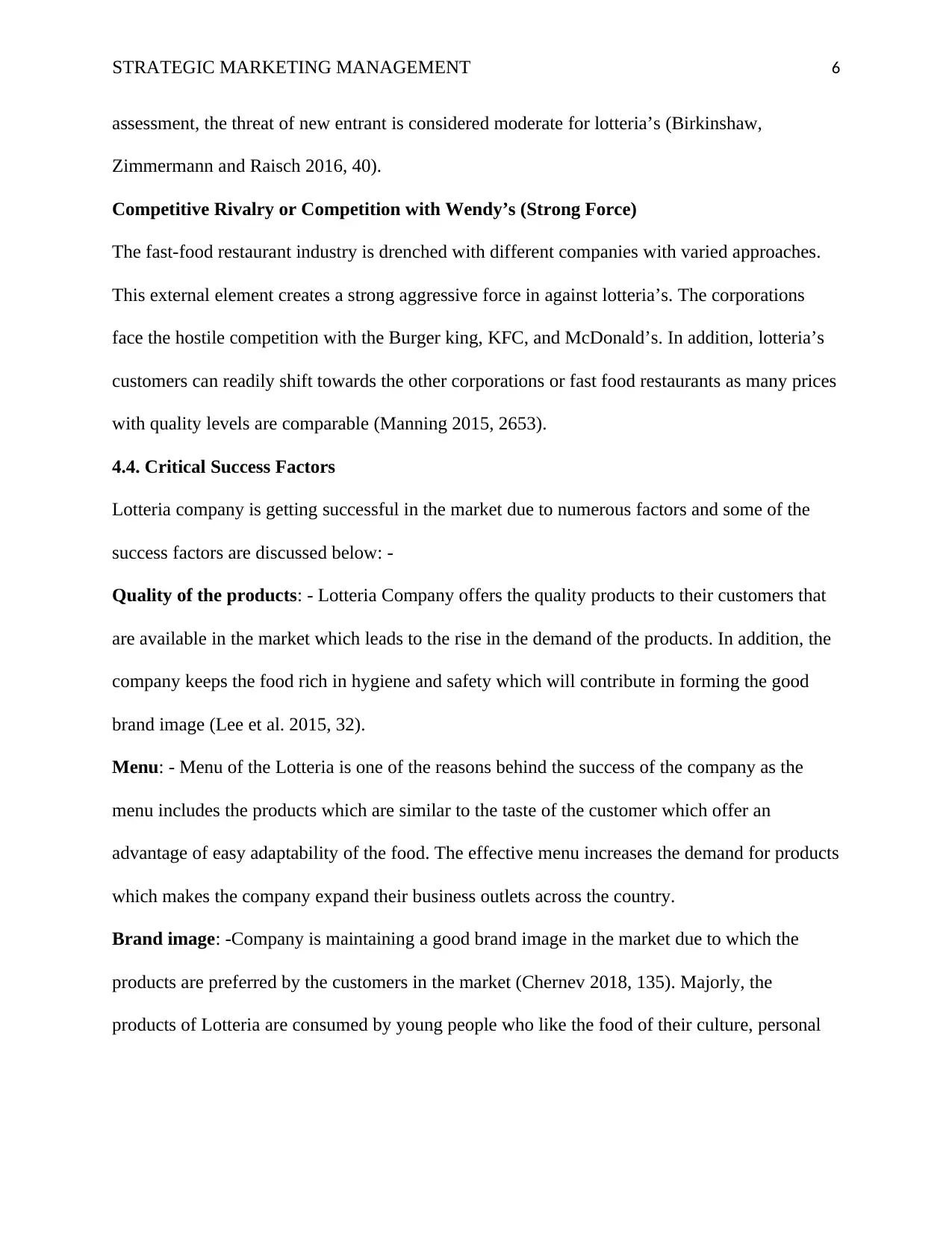
STRATEGIC MARKETING MANAGEMENT 6
assessment, the threat of new entrant is considered moderate for lotteria’s (Birkinshaw,
Zimmermann and Raisch 2016, 40).
Competitive Rivalry or Competition with Wendy’s (Strong Force)
The fast-food restaurant industry is drenched with different companies with varied approaches.
This external element creates a strong aggressive force in against lotteria’s. The corporations
face the hostile competition with the Burger king, KFC, and McDonald’s. In addition, lotteria’s
customers can readily shift towards the other corporations or fast food restaurants as many prices
with quality levels are comparable (Manning 2015, 2653).
4.4. Critical Success Factors
Lotteria company is getting successful in the market due to numerous factors and some of the
success factors are discussed below: -
Quality of the products: - Lotteria Company offers the quality products to their customers that
are available in the market which leads to the rise in the demand of the products. In addition, the
company keeps the food rich in hygiene and safety which will contribute in forming the good
brand image (Lee et al. 2015, 32).
Menu: - Menu of the Lotteria is one of the reasons behind the success of the company as the
menu includes the products which are similar to the taste of the customer which offer an
advantage of easy adaptability of the food. The effective menu increases the demand for products
which makes the company expand their business outlets across the country.
Brand image: -Company is maintaining a good brand image in the market due to which the
products are preferred by the customers in the market (Chernev 2018, 135). Majorly, the
products of Lotteria are consumed by young people who like the food of their culture, personal
assessment, the threat of new entrant is considered moderate for lotteria’s (Birkinshaw,
Zimmermann and Raisch 2016, 40).
Competitive Rivalry or Competition with Wendy’s (Strong Force)
The fast-food restaurant industry is drenched with different companies with varied approaches.
This external element creates a strong aggressive force in against lotteria’s. The corporations
face the hostile competition with the Burger king, KFC, and McDonald’s. In addition, lotteria’s
customers can readily shift towards the other corporations or fast food restaurants as many prices
with quality levels are comparable (Manning 2015, 2653).
4.4. Critical Success Factors
Lotteria company is getting successful in the market due to numerous factors and some of the
success factors are discussed below: -
Quality of the products: - Lotteria Company offers the quality products to their customers that
are available in the market which leads to the rise in the demand of the products. In addition, the
company keeps the food rich in hygiene and safety which will contribute in forming the good
brand image (Lee et al. 2015, 32).
Menu: - Menu of the Lotteria is one of the reasons behind the success of the company as the
menu includes the products which are similar to the taste of the customer which offer an
advantage of easy adaptability of the food. The effective menu increases the demand for products
which makes the company expand their business outlets across the country.
Brand image: -Company is maintaining a good brand image in the market due to which the
products are preferred by the customers in the market (Chernev 2018, 135). Majorly, the
products of Lotteria are consumed by young people who like the food of their culture, personal
⊘ This is a preview!⊘
Do you want full access?
Subscribe today to unlock all pages.

Trusted by 1+ million students worldwide
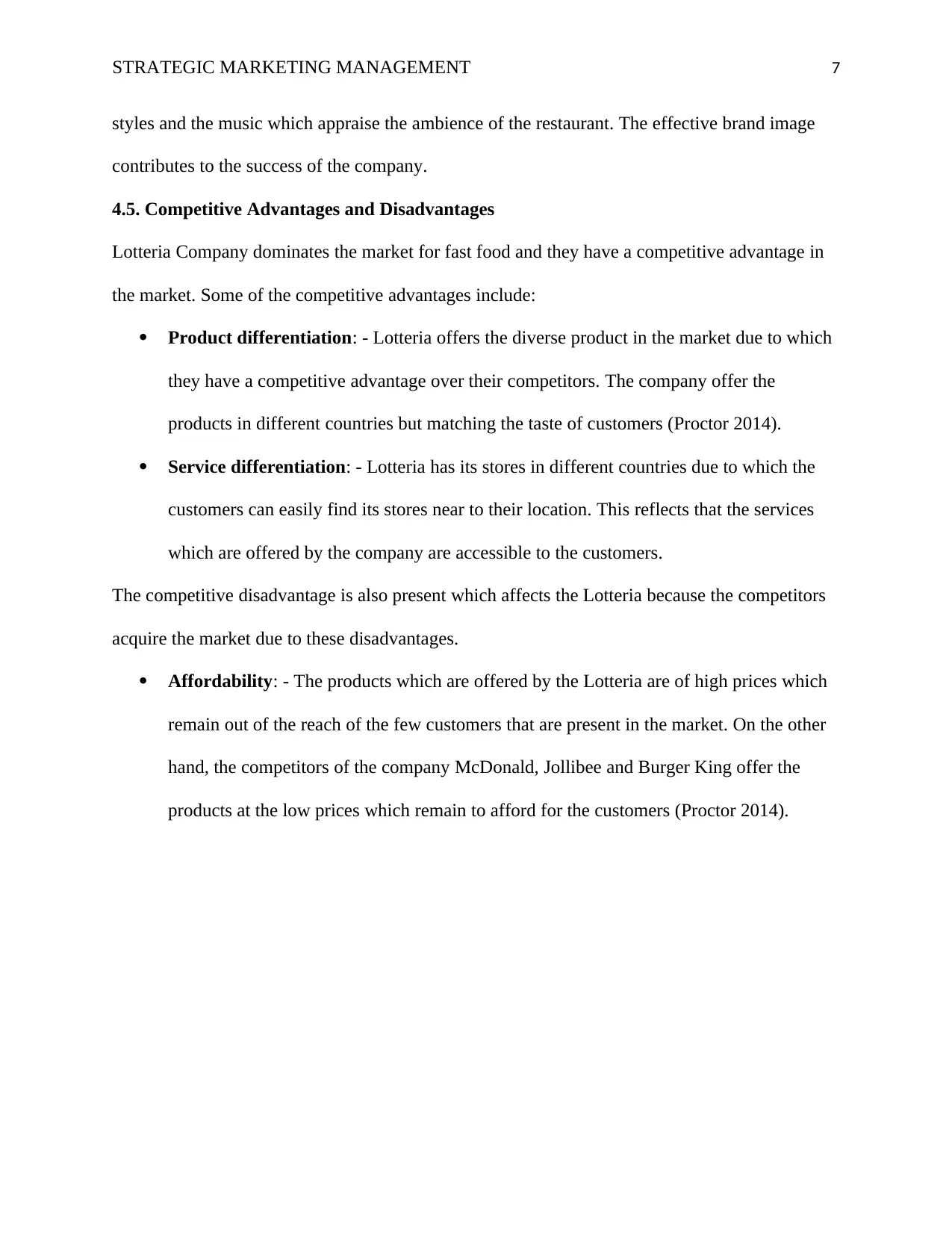
STRATEGIC MARKETING MANAGEMENT 7
styles and the music which appraise the ambience of the restaurant. The effective brand image
contributes to the success of the company.
4.5. Competitive Advantages and Disadvantages
Lotteria Company dominates the market for fast food and they have a competitive advantage in
the market. Some of the competitive advantages include:
Product differentiation: - Lotteria offers the diverse product in the market due to which
they have a competitive advantage over their competitors. The company offer the
products in different countries but matching the taste of customers (Proctor 2014).
Service differentiation: - Lotteria has its stores in different countries due to which the
customers can easily find its stores near to their location. This reflects that the services
which are offered by the company are accessible to the customers.
The competitive disadvantage is also present which affects the Lotteria because the competitors
acquire the market due to these disadvantages.
Affordability: - The products which are offered by the Lotteria are of high prices which
remain out of the reach of the few customers that are present in the market. On the other
hand, the competitors of the company McDonald, Jollibee and Burger King offer the
products at the low prices which remain to afford for the customers (Proctor 2014).
styles and the music which appraise the ambience of the restaurant. The effective brand image
contributes to the success of the company.
4.5. Competitive Advantages and Disadvantages
Lotteria Company dominates the market for fast food and they have a competitive advantage in
the market. Some of the competitive advantages include:
Product differentiation: - Lotteria offers the diverse product in the market due to which
they have a competitive advantage over their competitors. The company offer the
products in different countries but matching the taste of customers (Proctor 2014).
Service differentiation: - Lotteria has its stores in different countries due to which the
customers can easily find its stores near to their location. This reflects that the services
which are offered by the company are accessible to the customers.
The competitive disadvantage is also present which affects the Lotteria because the competitors
acquire the market due to these disadvantages.
Affordability: - The products which are offered by the Lotteria are of high prices which
remain out of the reach of the few customers that are present in the market. On the other
hand, the competitors of the company McDonald, Jollibee and Burger King offer the
products at the low prices which remain to afford for the customers (Proctor 2014).
Paraphrase This Document
Need a fresh take? Get an instant paraphrase of this document with our AI Paraphraser
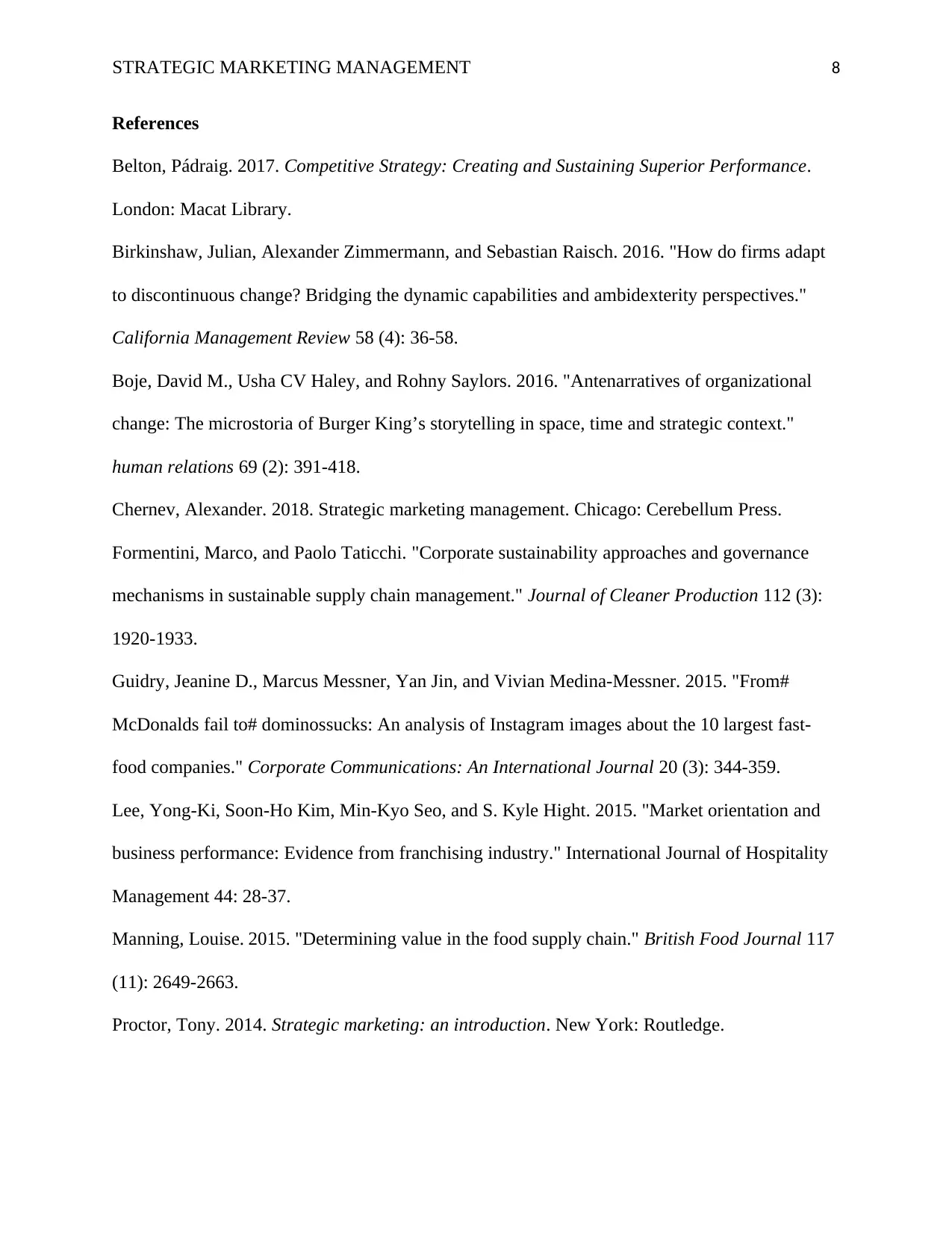
STRATEGIC MARKETING MANAGEMENT 8
References
Belton, Pádraig. 2017. Competitive Strategy: Creating and Sustaining Superior Performance.
London: Macat Library.
Birkinshaw, Julian, Alexander Zimmermann, and Sebastian Raisch. 2016. "How do firms adapt
to discontinuous change? Bridging the dynamic capabilities and ambidexterity perspectives."
California Management Review 58 (4): 36-58.
Boje, David M., Usha CV Haley, and Rohny Saylors. 2016. "Antenarratives of organizational
change: The microstoria of Burger King’s storytelling in space, time and strategic context."
human relations 69 (2): 391-418.
Chernev, Alexander. 2018. Strategic marketing management. Chicago: Cerebellum Press.
Formentini, Marco, and Paolo Taticchi. "Corporate sustainability approaches and governance
mechanisms in sustainable supply chain management." Journal of Cleaner Production 112 (3):
1920-1933.
Guidry, Jeanine D., Marcus Messner, Yan Jin, and Vivian Medina-Messner. 2015. "From#
McDonalds fail to# dominossucks: An analysis of Instagram images about the 10 largest fast-
food companies." Corporate Communications: An International Journal 20 (3): 344-359.
Lee, Yong-Ki, Soon-Ho Kim, Min-Kyo Seo, and S. Kyle Hight. 2015. "Market orientation and
business performance: Evidence from franchising industry." International Journal of Hospitality
Management 44: 28-37.
Manning, Louise. 2015. "Determining value in the food supply chain." British Food Journal 117
(11): 2649-2663.
Proctor, Tony. 2014. Strategic marketing: an introduction. New York: Routledge.
References
Belton, Pádraig. 2017. Competitive Strategy: Creating and Sustaining Superior Performance.
London: Macat Library.
Birkinshaw, Julian, Alexander Zimmermann, and Sebastian Raisch. 2016. "How do firms adapt
to discontinuous change? Bridging the dynamic capabilities and ambidexterity perspectives."
California Management Review 58 (4): 36-58.
Boje, David M., Usha CV Haley, and Rohny Saylors. 2016. "Antenarratives of organizational
change: The microstoria of Burger King’s storytelling in space, time and strategic context."
human relations 69 (2): 391-418.
Chernev, Alexander. 2018. Strategic marketing management. Chicago: Cerebellum Press.
Formentini, Marco, and Paolo Taticchi. "Corporate sustainability approaches and governance
mechanisms in sustainable supply chain management." Journal of Cleaner Production 112 (3):
1920-1933.
Guidry, Jeanine D., Marcus Messner, Yan Jin, and Vivian Medina-Messner. 2015. "From#
McDonalds fail to# dominossucks: An analysis of Instagram images about the 10 largest fast-
food companies." Corporate Communications: An International Journal 20 (3): 344-359.
Lee, Yong-Ki, Soon-Ho Kim, Min-Kyo Seo, and S. Kyle Hight. 2015. "Market orientation and
business performance: Evidence from franchising industry." International Journal of Hospitality
Management 44: 28-37.
Manning, Louise. 2015. "Determining value in the food supply chain." British Food Journal 117
(11): 2649-2663.
Proctor, Tony. 2014. Strategic marketing: an introduction. New York: Routledge.
1 out of 8
Related Documents
Your All-in-One AI-Powered Toolkit for Academic Success.
+13062052269
info@desklib.com
Available 24*7 on WhatsApp / Email
![[object Object]](/_next/static/media/star-bottom.7253800d.svg)
Unlock your academic potential
Copyright © 2020–2025 A2Z Services. All Rights Reserved. Developed and managed by ZUCOL.





